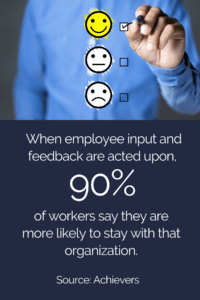Employee feedback can increase retention and productivity by guiding wanted adjustments to HR policy.
By Debbie Bolla
It’s an extremely challenging labor market and HR leaders simply can’t afford to lose their own talent. Organizations will need to be thoughtful in their approaches considering these statistics. Achievers’ 2021 Engagement & Retention Report revealed that one in five (19%) U.S. employees felt completely disengaged in their roles, a concerning number when 52% reported they were planning to look for a new job this year. A solution? Ongoing and frequent pulse surveys that track employee feedback and provide actionable advice.
“It is more important than ever for HR leaders to monitor employee sentiment as it is the best available tool for ensuring employee retention and to guide needed adjustments to policy or benefits,” says Hannah Yardley, Chief People and Culture Officer for Achievers. “By frequently reevaluating what employees want and need, HR teams can ensure they provide meaningful value to their current workforce in ways that improve overall sentiment.”
Pulse surveys are a key tool for HR leaders to gain a deep understanding of what’s working -and what’s not -at their organizations. Today’s employees are looking to have their voices heard by their employers. This approach provides timely, relevant feedback and helps track employee engagement. 
“By identifying the most critical engagement factors, it allows companies to focus their resources on what matters most to their employees,” says Yardley. “From there, continuing to measure engagement and sentiment as organizations implement new initiatives will allow leaders to understand where change is needed.”
Yardley also advises pairing pulse surveys with actionable change, a critical step that can be overlooked and cause further disengagement. These actions are most often done at the organizational level, but to distill it down to the source, consider the micro-actions that reflect the changes needed at the department, team, and individual level. When employee input and feedback are acted upon, 90% of workers say they are more likely to stay with that organization.
“Pulse surveys ensure that leaders understand what employees need as working conditions change, especially while navigating challenges associated with the pandemic,” Yardley explains. “In addition, make sure to ask the same or comparable questions on a weekly, monthly, or quarterly basis so you can track the company’s progress in a specific area.”
Here are some other best practices to make the most of pulse surveys and employee feedback.
- Have a specific purpose. Be clear and transparent about the reason for the survey. For example, a survey may seek feedback on recently implemented changes, or general input on job satisfaction.
- Make sure questions are audience appropriate.If employees don’t understand a question, they may skip it, or randomly select an answer, which will produce inaccurate results.
- Ask action-oriented questions. These questions will help leaders understand if employees see actions taken as a result of their previous participation in a survey. For example, gathering agreement levels to the statement, “I have seen positive changes take place on basis of our previous survey results,” will help paint a clear picture. Similarly, if there is no intention to action the changes in response to a question, it’s best not to ask the question in the first place!
- Keep the survey length short and easy to answer. Pulse surveys are supposed to be quick and easy to complete -think 5-15 questions max. Adding a few more questions can decrease participation and result quality.
There’s no one-size-fits-all approach to employee engagement surveys, so organizations need to tailor their strategy to meet their specific needs and business goals to help avoid unwanted attrition.














